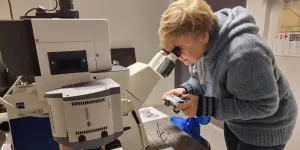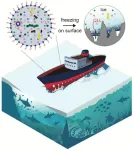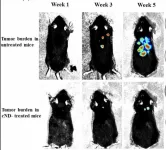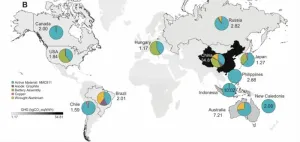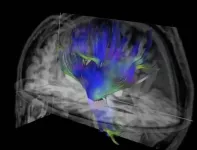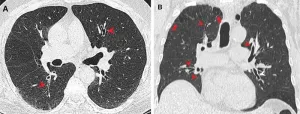(Press-News.org) Far too many antibiotics are used around the world. As a result, bacteria are becoming resistant.
Curing bacterial diseases is becoming more difficult than before, because antibiotics are perhaps our foremost weapons in the fight against them.
An important step towards using fewer antibiotics is to find better methods for identifying pathogens, and here is the good news.
“We have developed a simple tool that can identify all of the genetic material in bacteria. This allows us to find out more quickly what kind of bacteria a sick person or animal is affected by, or what kind of bacteria are found in food or the environment. We can then also decide whether it is necessary to use antibiotics against the bacterium, and if so what kind, so we don’t have to use as much medication,” says Professor Erika Eiser at Norwegian University of Science and Technology's (NTNU)Department of Physics.
No need to copy genetic material
An international research group is behind the latest findings. The results have been presented in the prestigious Proceedings of the National Academy of Sciences (PNAS) journal. Playing a key role in the work was Dr Peicheng Xu from the Institute of Physics Chinese Academy of Sciences in Beijing, for whom Eiser was previously an academic supervisor.
One reason why the new method is faster is that users do not have to go through a step called ‘gene amplification’. This involves making several copies of the genetic material so it is easier to analyse, but this step can now be skipped.
“We can analyse all of the bacterium’s DNA without gene amplification by using a method previously used in simulations,” says Professor Eiser.
Eiser was part of a research group led by Tine Curk from Johns Hopkins University that developed the theory behind the method, which also works in reality.
“We get excellent results when we apply the theoretical method to real samples,” says Professor Eiser.
The method creates clumps
This paragraph might be a bit difficult to understand, but basically, DNA is made up of rows of so-called nucleotides. The new method enables researchers to find short sequences of the bacteria’s DNA. They do this by seeing how these sequences bind to different variants of DNA that are grafted onto colloids, which are particles dissolved in a liquid.
If you are interested in finding out more, you can read about the process in more detail here. What it means, however, is that researchers can quickly identify the bacteria, because they bind themselves to these colloids in various ways and cause them to clump together.
The bottom line is: you don’t have to analyse so much material. You can skip the step of having to copy them, and this saves time and money.
“Using this method, we saw how as few as five E. coli bacteria caused the colloids to create clusters,” says Professor Eiser.
Still a way to go
All of this is currently in its early stages. Eiser has published a proof-of-principle experiment. This means that there is still a lot of work to be done before it becomes a widely used method.
“The findings can provide us with a reliable method for identifying pathogens in disciplines such as food safety, disease control and environmental monitoring,” says Professor Eiser.
In a world where more and more bacteria are becoming resistant to antibiotics, this is particularly good news.
References: P. Xu, T. Cao, Q. Fan, X. Wang, F. Ye, E. Eiser ‘Whole-Genome Detection using Multivalent DNA-Coated Colloids’ PNAS 120 (37), 2305995120; DOI: https://doi.org/10.1073/pnas.2305995120 (2023)
END
New method identifies bacteria more easily
A better method for identifying pathogens is an important step towards using fewer antibiotics.
2023-11-28
ELSE PRESS RELEASES FROM THIS DATE:
Bidding adieu to sticky ice, but with a grain of salt
2023-11-28
As Americans gear up for winter, many will face one of their toughest foes: ice. From delaying flights to making roads slippery, ice accumulation on surfaces wreaks havoc in many ways.
But not all ice is created equal. In new research from the University of Illinois Chicago, scientists studied the stickiness of ice containing everyday contaminants such as salt, soap and alcohol. Most laboratory studies typically test ice made from pure water, but in nature, ice is seldom pure.
“Be it dirty sidewalks or the hull of ...
CHOP researchers define seizure burden, developmental outcomes for STXBP1-related disorders
2023-11-28
Philadelphia, November 28, 2023 – Researchers from Children’s Hospital of Philadelphia (CHOP) found that seizure patterns and response to treatment strategies were able to help clinical teams determine epilepsy and developmental trajectories for patients with STXBP1-related disorders, one of the most common genetic epilepsy disorders. The findings were published online by the journal Brain.
Disease-causing variants in the gene STXBP1 are implicated in one of the most common genetic epilepsies and neurodevelopmental disorders, which are sometimes accompanied by autism spectrum disorder, increased or decreased muscle tone, or movement disorders. ...
Researchers identify three genes associated with neurodevelopmental disorders
2023-11-28
An international study group led by researchers of Children’s Hospital of Philadelphia (CHOP) have identified how three novel genes cause neurodevelopmental disorders. Researchers now have a better sense of the genes’ roles in human brain development and function and their ability to serve as potential therapeutic targets in the future. The findings were recently published online by the Journal of Clinical Investigation.
Over the last couple of decades, researchers have identified more than 1500 genes in different signaling pathways associated ...
Miss America’s Scholarship Foundation joins Go Red for Women to champion women’s health and well-being at every age
2023-11-28
DALLAS, November 28, 2023 — Cardiovascular disease (CVD) claims more lives than all forms of cancer, yet many women, particularly younger women, remain unaware.[1] Through its Go Red for Women® movement, the American Heart Association, which is devoted to a world of healthier lives for all, is being supported by Miss America’s Scholarship Foundation to empower the next generation of women to take charge of their health and make a lasting impact on the health and well-being of communities nationwide.
The ...
Nanodiamonds block tumor metastasis in mice
2023-11-28
Nanodiamonds are 2-8 nm carbon nanoparticles, which can be easily functionalized with various chemical groups like carboxylic groups or drugs. Previous research has shown that actively dividing cells are more likely to absorb nanodiamonds and that epithelial cells treated with carboxylic nanodiamonds lose the ability to migrate across cell permeable cellulose membranes. Rajiv K. Saxena and colleagues explored whether nanodiamonds might block tumor metastasis, a process that requires cell migration to new areas. The authors treated B16F10 melanoma cells with carboxylic nanodiamonds in culture and tested their ability to migrate and ...
Toward a sustainable EV battery supply chain globally
2023-11-28
Decarbonization of the global economy will require the production of a large number of batteries for electric vehicles (EVs). However, these batteries require energy and an array of minerals to produce and are not without their own environmental impacts. Fanran Meng and colleagues trace the energy consumption and greenhouse gas emissions in the global productions and supply chains of two common battery technologies as well as their future variants: nickel-manganese-cobalt (NMC) and lithium-iron-phosphate (LFP). Today, two-thirds of battery-related emissions occur in China (45%), Indonesia (13%), and Australia (9%), in part due to emissions-intensive electricity for ...
Mount Sinai creates research center focusing on opioids, emerging substances, and drug overdose
2023-11-28
The Icahn School of Medicine at Mount Sinai announced today the launch of a new center for “Research on Emerging Substances, Poisoning, and Overdose, for New Discoveries,” to be known as the RESPOND Center. Its research findings could lead to major advances in this area of medicine, including better treatments for patients with drug overdoses in emergency departments across the United States.
“Each day, clinicians on the front lines bear witness to devastating impacts from the current epidemic ...
Soccer heading linked to measurable decline in brain function
2023-11-28
CHICAGO – New research being presented this week at the annual meeting of the Radiological Society of North America (RSNA) links soccer heading – where players hit the ball with their head – to a measurable decline in the microstructure and function of the brain over a two-year period.
“There is enormous worldwide concern for brain injury in general and in the potential for soccer heading to cause long-term adverse brain effects in particular,” said senior author Michael L. Lipton, M.D., Ph.D., professor of radiology at Columbia University’s Vagelos College of Physicians and Surgeons and affiliate professor of ...
Marijuana, cigarette smokers at increased risk of emphysema
2023-11-28
CHICAGO – Smoking marijuana in combination with cigarettes may lead to increased damage of the lung’s air sacs, according to research being presented today at the annual meeting of the Radiological Society of North America (RSNA).
It is commonly believed that smoking marijuana is not harmful to the lungs. There is an abundance of established research that identifies the harms of cigarette smoking. In contrast, very little is known about the effects of marijuana smoking, and even less research has been done on the combined effects of smoking marijuana and cigarettes.
“Marijuana is the most widely used illicit psychoactive ...
New strategies generate more accurate pediatric brain organoids
2023-11-28
Essential features of the cortex, an important part of the human brain and its development, are more accurately captured in organoids generated by researchers of the Princess Máxima Center for pediatric oncology and the Hubrecht Institute. The scientists developed mini-organs with features like cell organization, stem cell expansion and cell identity that more closely mimic the real-life situation. These novel organoids can be used as a basis to model pediatric brain tumors.
Multiple childhood brain tumors, like cortical gliomas, arise from the cortex, the outer layer of the largest part of the brain and the brain’s ...
LAST 30 PRESS RELEASES:
Numbers in our sights affect how we perceive space
SIMJ announces global collaborative book project in commemoration of its 75th anniversary
Air pollution exposure and birth weight
Obstructive sleep apnea risk and mental health conditions among older adults
How talking slows eye movements behind the wheel
The Ceramic Society of Japan’s Oxoate Ceramics Research Association launches new international book project
Heart-brain connection: international study reveals the role of the vagus nerve in keeping the heart young
Researchers identify Rb1 as a predictive biomarker for a new therapeutic strategy in some breast cancers
Survey reveals ethical gaps slowing AI adoption in pediatric surgery
Stimulant ADHD medications work differently than thought
AI overestimates how smart people are, according to HSE economists
HSE researchers create genome-wide map of quadruplexes
Scientists boost cell "powerhouses" to burn more calories
Automatic label checking: The missing step in making reliable medical AI
Low daily alcohol intake linked to 50% heightened mouth cancer risk in India
American Meteorological Society announces Rick Spinrad as 2026 President-Elect
Biomass-based carbon capture spotlighted in newly released global climate webinar recording
Illuminating invisible nano pollutants: advanced bioimaging tracks the full journey of emerging nanoscale contaminants in living systems
How does age affect recovery from spinal cord injury?
Novel AI tool offers prognosis for patients with head and neck cancer
Fathers’ microplastic exposure tied to their children’s metabolic problems
Research validates laboratory model for studying high-grade serous ovarian cancer
SIR 2026 delivers transformative breakthroughs in minimally invasive medicine to improve patient care
Stem Cell Reports most downloaded papers of 2025 highlight the breadth and impact of stem cell research
Oxford-led study estimates NHS spends around 3% of its primary and secondary care budget on the health impacts of heat and cold in England
A researcher’s long quest leads to a smart composite breakthrough
Urban wild bees act as “microbial sensors” of city health.
New study finds where you live affects recovery after a hip fracture
Forecasting the impact of fully automated vehicle adoption on US road traffic injuries
Alcohol-related hospitalizations from 2016 to 2022
[Press-News.org] New method identifies bacteria more easilyA better method for identifying pathogens is an important step towards using fewer antibiotics.
